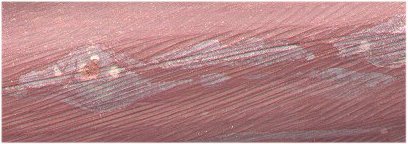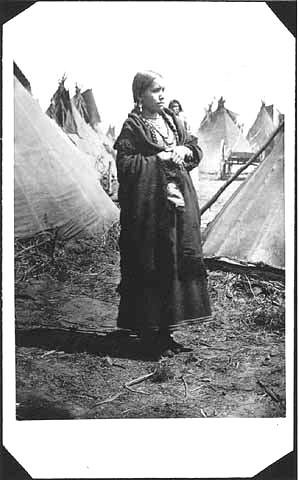Catlinite
The
Real McCoy!
The
soft red stone which comes from the sacred quarries in Pipestone,
is scientifically known as Catlinite. It feels smooth to the
touch, and is easily carved with a regular pen-knife. Most
Catlinite is not pure red all the way through, it normally
has small lighter pigments scattered in the dark red, these
are known as stars, and the markings can often look like a
universe in the making.
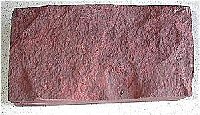 1 1 |
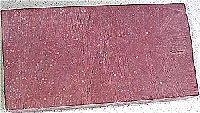 2 2 |
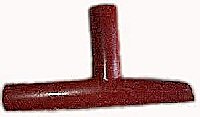 3 3 |
|
The
picture above is of raw pipestone as it comes out of
the earth. As you can see it looks nothing like the
finished stone.
|
Once
the stone is cut it looks like the above picture, you
can see the lighter specks in the stone.
|
This
is what the polished stone looks like, this has beeswax
on it to give it a shine.
|
Take
a look at picture 2 above, this is how the stone can look
with the lighter spots in it. These markings come from the
bleaching of the hematite in the metamorphic clay over the
centuries. It is nature at it's finest, the lighter areas
can often look like an animal, a bird, or an insect. Sometimes
a different type of picture can show such as a shell, a human,
a tree. You just need to look into the color to see these
shapes.
Pictures
in the Stone
|
In
2001, Chuck carved a Pipe for a Canadian Native American.
As he looked for a piece of stone to use, four times
this piece insisted that it be used, he turned it down
three times as he didn't think it would be big enough,
and on the fourth realized that it should be used. As
he carved the Pipe the following image came through:
Is this a Canada Goose? We thought so.
|
|
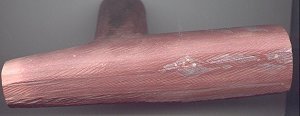 |
This
shows that the pictures are there for a reason, and
they want to come out in the Pipe. Spirit IS in the
genuine Catlinite stone. This is shown in the early
stage of carving. We took the photo early on in the
process because we thought the picture would be carved
out. However it wasn't the goose stayed and is happily
with it's new owner in Canada.
|
|
|
In
2003 a pipe was crafted for a Native American woman's
group, who are commemorating their ancestors of 1862.
When the markings in this pipe was shown to me I recognised
the shape as one of the photos I had seen from 1862.
The Pipe was presented to the group with the original
photo (picture is on the left) showing the young pregnant
woman who appeared in the stone.
Dakota
Womans March
Photograph
courtesy of the Minnesota Historical Society
|
You
can see by the pictures above the various colors in the stone.
The finished color looks completely different to the raw stone
shown in pictures 1 and 2. Many people think that the stone
comes out red like this. In the old days the polish used was
buffalo tallow.
Another
phenomena that shows itself is what the crafts-people call
a heart-line. It is a hair-thick line that is straight and
a different color, (usually black,) to the stone. It looks
like a crack but it isn't. If one of these is found in the
stone, it is thought to be highly lucky for both the crafts-person
and the person who ends up with the item it is in.
|
The
scientific breakdown of Catlinite
Silica-------------
48.20 Mangananous Oxide------------ 0.60
Ferric Oxide----------- 5.00 Magnesia----------------
6.00
Alumina------------ 28.20 Water-----------------
8.40
Carbonate of Lime ---------------- 2.60 Loss-----------------------
1.00
Analysis
by Dr. Charles F. Jackson, Boston chemist. circa
1836
Catlinite
is chemically a clay (silicate of alumina) colored brick
red with peroxide of iron.
In
a museum article it was said that Indians preferred
this more pure clay over other red stone found else
where, and that the jasper stone had more quartz in
it.
|
The
look-alike stone:
The
non-native quarries are near the tiny town of Jasper, these
are privately owned quarries, where stone that looks like
Catlinite is obtained. The man who owned one of the quarries
proudly stated a few years ago that he supplied 95% of all
pipestone sold. The reason that he could do this is because
he got to the stone by using machinery and so could get out
hundreds of pounds at a time. The problem is that this stone
is not pipestone even though it was advertised as being from
the quarries in SW Minnesota. Of course that quarry is in
SW Minnesota as well as the sacred quarries, so it made it
look like the stone comes from the Native American quarries.
Now think about this for a minute, if he was selling 95% of
all stone sold back then and we didn't know about it how many
people obtained stone that they thought was the sacred stone,
only to find out that is wasn't. How many people bought that
stone to keep as an heirloom or to keep on an alter? That
stone is probably still there now, and the poor person doesn't
realize it is not genuine stone from the sacred quarries......
That is fine in a way, but in another way it isn't because
it was sold under false pretences as something sacred.....
It may interest you to know that the man who was selling all
of this stone eventually lost a couple of fingers, so Creator
did do something about it. He has since sold his business
and the stone is still being sold, mostly on Ebay, so please
be careful where you get yours from......
The
Jasper stone as it is called (please note that this is
not the gemstone called Jasper) feels grittier, it doesn't
have that smooth buttery feel that the Catlinite does. If
you try to cut it with a knife it cracks away, often it breaks
as it is being crafted, or it breaks the craftspersons tools.
The color is different too, it has a more purple look to it.
The chemical make up of the stone has more quartz in it. This
is the reason that it doesn't cut as well as Pipestone. It
also has a more metalic taste to it.
The
biggest difference is the dust, Catlinite dust has healing
qualities, the other stone does not. Pipestone craftspeople
have for many years been working with the dust all around
them. Never do they use a face mask, and never have they had
any lung problems. A couple of women have astma, but they
still make craft items and it doesn't cause them to have an
attack. When you go to a craftspersons home there is always
pink dust around from their work over the years. It does no
harm. However, we have seen people using the other stone and
they use a mask, because the dust is sharper and can cause
lung problems. We
have also heard that the dust causes the skin to burn in the
sun, but the true stone dust is used by sundancers to protect
their skin, a big difference wouldn't you think?
Lately
I have been calling the false stone 'Fool's Stone' which is
in the same concept of 'Fool's Gold', so much of the gold
mined in the late 1800's was Fool's Gold, but the miners thought
it was real gold. This stone is the same, many people think
it is the real Catlinite, and they try to make Ceremonial
items from it. Sometimes if they are lucky the stone can be
formed into a Pipe, but we have heard more than once that
the ceremonies have gone wrong. I would personally say that
is because Spirit is not in the Fool's Stone. It is like a
Heyoka stone, causing things to go contrary to how they should.
More
and more Natives are coming and telling us about the stone
they were gifted or got from a store to make a channupa from
only to find it cracked and they couldn't do it. There are
many angry people out there right now who want something done
about the people selling this stone as Pipestone stone. Native
Americans have had enough of this issue.
1.
To end this page I wish to reiterate that no-one from the
Original Pipestone Dakota Tiospaye is making a lot of money
through the stone. What is sold is recompense for their time
in quarrying and making the item.
2.
The Pipestone quarries are not being desecrated by the quarriers
or anyone else.
3.
There are no tourists running around tearing down trees or
plants or acting disrespectful in the Pipestone Monument area.
When people walk into the Sacred area it is as if a peacefulness
overcomes them and they walk quietly, with respect. They ask
questions when they see a Native American in very quiet tones,
and seem to understand that the whole place has a magical
(Wakan) quality to it which they cannot explain but know it's
there. Recently an email came in from a visitor to Pipestone
and I am quoting it here because it says it all.....
'My
first impressions was that it (The National Monument) was
a very low key place, quiet, warm in the late summer breezes
and, as I think about it now it had an ethereal presence.
Kind of like walking into a church sanctuary on a Saturday
afternoon when no one is there. ' R W-W.
4. Energies do not subside over the years, the power that
the ancients felt here is still present, and it always will
be here. Primitive energies that make things happen.
To
see photos of the actual false quarries and the ancient quarry
please go HERE. and HERE.
If
you have obtained some red stone from a rock shop or E-Bay
please be aware that it is almost certainly NOT
from the ancient Pipestone Quarries.
If you paid less than $10 a pound for it then again it has
most likely not been hand quarries by a Native American.
Even
if you bought the stone from a Native American that is not
a valid reason to say that it is genuine Catlinite. We know
of one Native man who got his permit then stocked up with
the false stone and went back to his home state to sell the
stone. He had a permit, he had red stone, but that stone was
not true pipestone.
|

 1
1 2
2 3
3